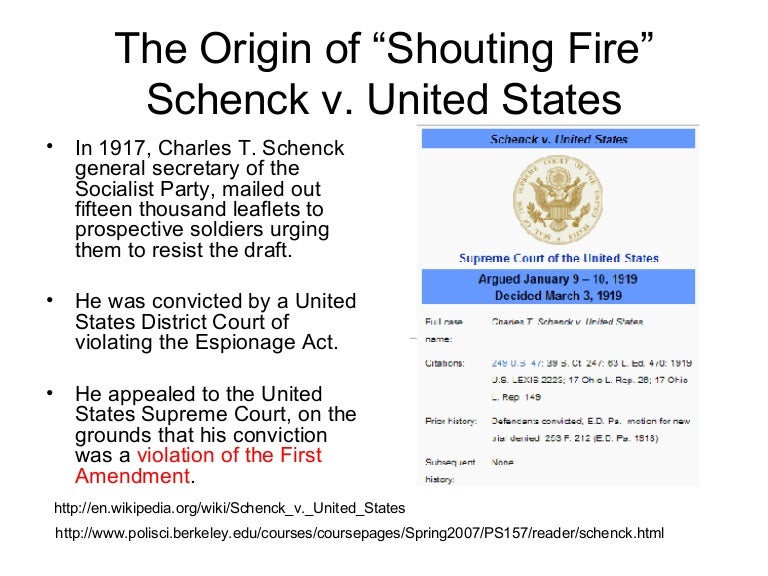During World War I th. Supreme Court ruled on March 3 1919 that the freedom of speech protection afforded in the US.
 Schenck V United States Wikiwand
Schenck V United States Wikiwand
Schenck mailed out circulars criticizing draft supporters and informing draftees of their rights to oppose.

Schenck v united states summary. Schenck was charged with conspiracy to violate the Espionage Act of 1917 by attempting to cause insubordination in the military and to obstruct recruitment. Schenck and Baer were convicted of violating this law and appealed on the grounds that the statute violated the First Amendment. Case summary for Schenck v.
The second charge was that the United States thought this document was a conspiracy to commit an offense against the United States. This case is based on a three count indictment. The United States believed that Schenck was attempting to cause insubordination in the Military and Naval forces of the United States.
Significance of Schenck v. The third count alleges an unlawful use of the. Constitution s First Amendment could be restricted if the words spoken or printed represented to society a clear and present danger.
Schenck who was found guilty in the original trial appealed the charges by claiming the US. In response Schenck was indicted for violating the Espionage Act the Act which made it a crime to interfere with military success or promote the success of its enemies during wartime. 47 1919 the Supreme Court affirmed the conviction of Charles Schenck and Elizabeth Baer for violating the Espionage Act of 1917 through actions that obstructed the recruiting or enlistment service during World War I.
United States 232 US. The United States This had a huge significance at the time. New York 192 US.
United States 249 US. Had sparked slave-like laws. The search warrant did not issue against the defendant but against the Socialist headquarters at 1326 Arch Street and it would seem that the documents technically were not even in the defendants possession.
Schenck pointed to the 13th Amendment as his main support. In the landmark Schenck v. United States legal case in which the US.
The United States took place from January 9th 1919 to January 10th. The second alleges a conspiracy to commit an offense against the United States. United States was a Supreme Court Case that explained some limits to the Freedom of Speech afforded by the First Amendment.
This Amendment outlawed slavery and forced service. United States was an important early test of the constitutionality of the Espionage Act of 1917. To cause insubordination c in the military and naval forces of the United States and to obstruct the recruiting and enlistment service of the United States when the United States was at war with the German Empire to-wit that the defendants willfully conspired to have printed and circulated to men who had been called and accepted for military service under the Act of May 18 1917 a.
It seriously lessened the strength of the First Amendment during times of war by removing its protections of the freedom of speech when that speech could incite a criminal action like dodging the draft. In a unanimous decision the Supreme Court upheld the conviction under the Espionage Act of two leaders of Philadelphias Socialist Party who had distributed fliers urging their readers to. The first charge was a conspiracy to violate the Espionage Act of 1917.
The case of Schenck v. The Clear and Present Danger rule lasted until 1969.
 Schenck V United States Chs 260 Studocu
Schenck V United States Chs 260 Studocu
 Schenck V United States 1919 In This 1919 Case The Court Ruled That The Conviction Of A Defendant For Sending A Leaflet To Draftees When The Nation Was Ppt Download
Schenck V United States 1919 In This 1919 Case The Court Ruled That The Conviction Of A Defendant For Sending A Leaflet To Draftees When The Nation Was Ppt Download
 Schenck Vs United States Explained In 5 Minutes Us History Review Youtube
Schenck Vs United States Explained In 5 Minutes Us History Review Youtube
Standard 12 3 American Government
 Freedom Of Speech And The Supreme Court Ppt Video Online Download
Freedom Of Speech And The Supreme Court Ppt Video Online Download
Schenk Vs United States Lessons Blendspace
 The Supreme Court Capitalism And Conflict Landmark Cases Schenck V U S 1919 Pbs
The Supreme Court Capitalism And Conflict Landmark Cases Schenck V U S 1919 Pbs

